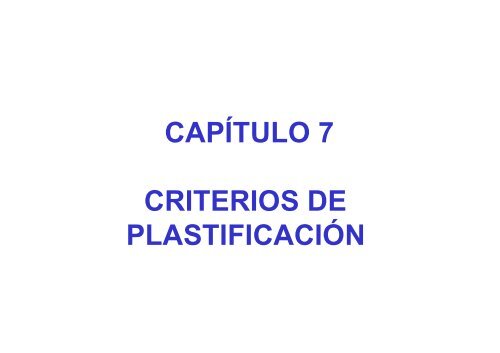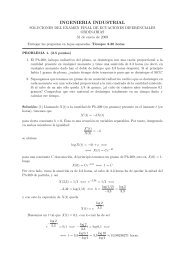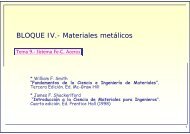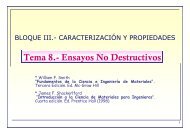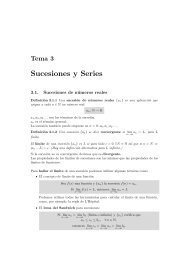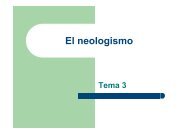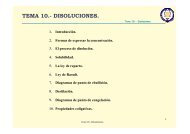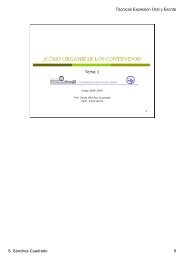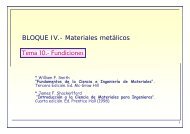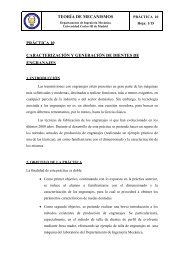CAPÍTULO 7 CRITERIOS DE PLASTIFICACIÓN - OCW - UC3M
CAPÍTULO 7 CRITERIOS DE PLASTIFICACIÓN - OCW - UC3M
CAPÍTULO 7 CRITERIOS DE PLASTIFICACIÓN - OCW - UC3M
You also want an ePaper? Increase the reach of your titles
YUMPU automatically turns print PDFs into web optimized ePapers that Google loves.
<strong>CAPÍTULO</strong> 7<br />
<strong>CRITERIOS</strong> <strong>DE</strong><br />
<strong>PLASTIFICACIÓN</strong>
ENSAYO <strong>DE</strong> TRACCIÓN SIMPLE<br />
P<br />
Si<br />
Si<br />
Efecto<br />
Bauschinger<br />
tracción<br />
σ ≤ σ<br />
σ ≥ σ<br />
σ t<br />
y<br />
compresión<br />
c<br />
σ y<br />
σ<br />
y<br />
y<br />
σ<br />
σ<br />
Comportamiento<br />
Comportamiento<br />
ε<br />
elástico<br />
plástico<br />
σ<br />
1<br />
σ t<br />
y<br />
σ<br />
del<br />
del<br />
σ<br />
ε p<br />
material<br />
material<br />
ε<br />
ε<br />
Efecto<br />
de histéresis
ESTADO TENSIONAL TRIDIMENSIONAL<br />
¿Cuándo se produce la plastificación de este punto elástico?<br />
CRITERIO <strong>DE</strong> <strong>PLASTIFICACIÓN</strong><br />
f ( σ<br />
, σ , σ , τ , τ , τ ) =<br />
x<br />
y<br />
z<br />
xy<br />
xz<br />
yz<br />
0
CRITERIO <strong>DE</strong> <strong>PLASTIFICACIÓN</strong> PARA UN<br />
MATERIAL ISÓTROPO<br />
Las propiedades mecánicas no dependen de la dirección<br />
en que se midan. Esto lleva a la afirmación de que no<br />
existe, dentro del sólido, ninguna dirección que predomine<br />
sobre las demás. Por tanto, un criterio de plastificación<br />
debería venir expresado en función de los invariantes del<br />
tensor de tensiones (magnitudes independientes del<br />
sistema de referencia que se tome) y no en función de las<br />
componentes del tensor en un sistema de referencia en<br />
particular.<br />
En base a esto, el criterio de plastificación debe tener la<br />
siguiente formulación:<br />
f<br />
( I 1 , I 2 , I 3<br />
)<br />
=<br />
0
En el caso de materiales metálicos, se ha comprobado experimentalmente<br />
que, el fenómeno de plastificación en un punto, es independiente de la<br />
componente hidrostática p del tensor de tensiones. Por tanto, en estos<br />
materiales, el criterio de plastificación debe venir expresado en función de<br />
los invariantes J 1 , J 2 y J 3 de la parte desviadora del tensor de tensiones.<br />
J<br />
J<br />
J<br />
1<br />
2<br />
3<br />
=<br />
0<br />
= σ ′ σ ′<br />
1<br />
1<br />
2<br />
= σ ′ σ ′ σ ′<br />
2<br />
+ σ ′ σ ′<br />
3<br />
2<br />
3<br />
+ σ ′ σ ′<br />
3<br />
1<br />
p<br />
f ( J 2 , J3<br />
σ 1 + σ 2 + σ 3<br />
=<br />
3<br />
)<br />
=<br />
0<br />
σ ′<br />
1<br />
σ ′<br />
2<br />
σ ′<br />
3<br />
= σ<br />
= σ<br />
= σ<br />
Si el material no posee el efecto Bauschinger, el límite elástico no cambiaría<br />
al cambiar el signo de las tensiones aplicadas. Como quiera que J3 es función<br />
impar de σ 1 ′ , σ 2′<br />
, σ 3′<br />
la función de plastificación no podría depender de este<br />
invariante, por lo que, para metales, el criterio de plastificación debe ser del<br />
tipo:<br />
f<br />
( J 2<br />
)<br />
=<br />
0<br />
1<br />
2<br />
3<br />
−<br />
−<br />
−<br />
p<br />
p<br />
p
REPRESENTACIÓN GEOMÉTRICA <strong>DE</strong> LA <strong>PLASTIFICACIÓN</strong><br />
σ 3<br />
σ 3<br />
,<br />
O<br />
P<br />
Q<br />
,<br />
σ 2<br />
σ 2<br />
π<br />
,<br />
σ 1<br />
plano π: perpendicular a la bisectriz del primer cuadrante de ese sistema de<br />
referencia que, además, tiene su origen en un punto de dicho plano<br />
σ 1<br />
σ 2<br />
, σ 1<br />
σ 3<br />
r<br />
,<br />
θ<br />
Q<br />
,
SUPERFICIE Y LUGAR <strong>DE</strong> PLASTIFICACION<br />
Superficie de plastificación se define como el lugar geométrico de los puntos<br />
σ 1 , σ 2 , σ 3 en los que se cumple el criterio de plastificación.<br />
σ 3<br />
Lugar de<br />
plastificación<br />
σ 2<br />
π<br />
Superficie de<br />
plastificación<br />
σ 1
El corte de la superficie de plastificación con el plano π recibe el nombre<br />
de lugar de plastificación<br />
Lugar de plastificación<br />
σ 2<br />
, σ 1<br />
σ 3<br />
El lugar de plastificación debe cumplir unas determinadas condiciones:<br />
•debe ser simétrico respecto de los ejes ya que el criterio de plastificación no varía<br />
al intercambiar la dirección de las tensiones principales.<br />
•debe ser simétrico respecto de las rectas perpendiculares a los ejes en el origen<br />
como consecuencia de que el material no presenta el efecto Bauschinger.<br />
,<br />
Q 1<br />
Q 2<br />
,
CRITERIO <strong>DE</strong> PLASTIFICACION <strong>DE</strong> TRESCA<br />
La plastificación de un punto elástico tendrá lugar cuando<br />
la máxima tensión tangencial que actúe sobre el punto<br />
elástico considerado alcance un valor crítico k.<br />
σ ≥<br />
1<br />
≥ σ 2 σ σ − σ = 2k<br />
3<br />
1<br />
3<br />
Henri<br />
TRESCA<br />
(1841-1884)<br />
¿Cómo podemos deducir el valor de k a partir, por ejemplo, de la tensión<br />
de plastificación σ y obtenida en un ensayo convencional de tracción o<br />
Dde compresión?<br />
σ 1 σ y<br />
= σ = σ<br />
2<br />
3<br />
=<br />
0<br />
k<br />
=<br />
σ<br />
y<br />
2
SUPERFICIE <strong>DE</strong> PLASTIFICACION <strong>DE</strong> TRESCA<br />
σ 1<br />
σ 3<br />
π<br />
σ 2
CRITERIO <strong>DE</strong> PLASTIFICACION <strong>DE</strong> VON MISES Richard<br />
La plastificación tiene lugar cuando el segundo<br />
invariante del tensor de tensiones desviadoras es<br />
igual al cuadrado de una constante k’ propiedad<br />
del material<br />
J = (k ′ )<br />
2<br />
2<br />
( σ −σ<br />
) + ( σ −σ<br />
) + ( σ −σ<br />
)<br />
1<br />
2<br />
2<br />
2<br />
3<br />
3<br />
2<br />
VON MISES<br />
(1883-1953)<br />
( ) 2 ( ) 2 ( ) 2 ( 2 2 2 ) 2<br />
σ −σ<br />
+ σ −σ<br />
+ σ −σ<br />
+ 6 τ + τ + τ = 6(<br />
k′<br />
)<br />
x<br />
y<br />
y<br />
z<br />
z<br />
1<br />
x<br />
2<br />
= 6(<br />
k′<br />
)<br />
La forma de determinar el valor del parámetro k’ es<br />
similar a la que vimos para el criterio de Tresca:<br />
σ 1 = σ y , σ 2 = σ 3<br />
2<br />
2 = 2 y<br />
J σ<br />
=<br />
0<br />
J<br />
2<br />
y<br />
xy<br />
2<br />
( k′<br />
)<br />
2<br />
=<br />
2σ<br />
= 6 ⇒ k′<br />
=<br />
2<br />
yz<br />
xz<br />
σ<br />
y<br />
3
Principio físico de la teoría de Von Mises<br />
La plastificación se produce si U d (Energía de<br />
distorsión) alcanza el mismo valor de U d cuando<br />
se produce la plastificación en un ensayo de<br />
tracción<br />
Concepto de Energía de distorsión :<br />
Energía consumida para obtener un cambio<br />
de forma del punto elástico sin que éste<br />
cambie ni de dimensiones y ni de volumen.<br />
U = U − U<br />
d T V<br />
E. de distorsión E. Total E. necesaria para un<br />
cambio de volumen
1-<br />
∆V<br />
Calculemos el cambio de volumen de un punto elástico<br />
sometido a las tensiones σ 1 , σ 2 , σ 3 .<br />
= 1+<br />
ε + ε<br />
1<br />
=<br />
[ ( 1+<br />
ε )( 1+<br />
ε )( 1+<br />
ε ) −1]<br />
1<br />
≈ ε + ε<br />
2<br />
2<br />
1<br />
+ ε<br />
+ ε<br />
3<br />
Como quiera que:<br />
llegamos a que:<br />
3<br />
2<br />
+ ε<br />
1<br />
∆ V =<br />
ε<br />
2<br />
( σ + σ )<br />
σ 1 ν 2<br />
ε1<br />
= −<br />
E E<br />
σ 2 ν σ 1 + σ 3<br />
ε 2 = −<br />
E E<br />
σ 3 ν σ 1 + σ 2<br />
ε 3 =<br />
−<br />
E E<br />
3<br />
( )<br />
( )<br />
3<br />
+ ε<br />
1<br />
ε<br />
3<br />
+ ε<br />
( σ + σ + σ )( 1−2v) 1 2 3<br />
E<br />
=<br />
2<br />
ε<br />
1<br />
2<br />
3<br />
3<br />
+ ε<br />
1<br />
ε<br />
2<br />
ε<br />
3<br />
−1<br />
≈
2-<br />
3-<br />
Calculemos la tensión hidrostática que produciría la misma<br />
variación de volumen (∆V):<br />
3<br />
∆V = 3e = σ hidrostática<br />
− 2<br />
U<br />
Calculemos UT para<br />
el punto elástico :<br />
T<br />
v E<br />
1[<br />
1 σ ∈1 2∈2 3∈3] 1ε1<br />
+ σ 2ε<br />
2 + σ 3<br />
2<br />
1<br />
= + +<br />
= 2<br />
U σ σ σ<br />
T<br />
( 1 ν )<br />
[ ε ]<br />
3<br />
σ<br />
hidrostática<br />
σ 1 + σ 2 + σ 3<br />
=<br />
3<br />
U T para un resorte :<br />
K x<br />
Ut = F⋅ x U<br />
2 t =<br />
2<br />
2
Utilizando las ecuaciones , y<br />
1 2 3<br />
UT<br />
1<br />
= + + −<br />
2E<br />
1 2 3<br />
v<br />
( σ 2 σ 2 σ 2)(<br />
1 2 )<br />
3<br />
2E<br />
2<br />
4-<br />
U V = σ av<br />
( 1−2v) U<br />
5-<br />
Calculemos U V<br />
U V<br />
3 2<br />
1<br />
= 1− 2 + + + 2 + 2 + 2<br />
6E<br />
( v)( σ 2 σ 2 σ 2 σσ σσ σσ )<br />
V<br />
1 2 3<br />
1 2 1 3 2 3<br />
Despejemos U d<br />
( 1−<br />
ν )<br />
= σ 2<br />
hidrostática<br />
2E<br />
v σ σ σ σ σ σ<br />
( − ) + ( − ) + ( − )<br />
2 2 2<br />
1 + ⎡ ⎤<br />
1 2 2 3 3 1<br />
U d = U T − U V = ⎢ ⎥<br />
3E⎢2 ⎣ ⎥<br />
1444444444444244444444444443 ⎦<br />
A
6-<br />
7-<br />
8-<br />
9-<br />
Calculemos Ud cuando se produce la plastificación en un<br />
ensayo de tracción:<br />
1 1+<br />
+ νv<br />
2<br />
2<br />
U U<br />
d<br />
d=<br />
= σ y S y 3E<br />
σ y = límite elástico del material<br />
Igualando las expresiones A y B<br />
2<br />
S<br />
σ y<br />
σ σ σ σ σ σ<br />
( − ) + ( − ) + ( − )<br />
2 2 2<br />
1 2 2 3 3 1<br />
2<br />
=<br />
y<br />
2<br />
=<br />
y<br />
2<br />
⎡( 2 ⎣<br />
− ) + ( − ) + ( − ) ⎤<br />
⎦<br />
S σ σ σ σ σ σ<br />
σ y<br />
2 2 2<br />
1<br />
2<br />
1 2 2 3 3 1<br />
2<br />
2<br />
σ σ σ σ σ σ σ<br />
2 2 2<br />
1<br />
2<br />
1 2 2 3 3 1<br />
Llamando = ( − ) + ( − ) + ( − )<br />
e<br />
1 44 23 E4<br />
43<br />
B<br />
⎡ ⎤<br />
⎣ ⎦<br />
La plastificación se produce cuando σ e ≥ S y<br />
Tensión equivalente de Von Mises.<br />
σ<br />
y
SUPERFICIE <strong>DE</strong> PLASTIFICACION <strong>DE</strong> VON MISES<br />
,<br />
σ3 σ1 σ1 σ 3<br />
,<br />
σ1 σ<br />
π<br />
,<br />
σ2 s<br />
p<br />
3<br />
R = σ y<br />
2<br />
σ 2
COMPARACIÓN ENTRE LOS LUGARES <strong>DE</strong> <strong>PLASTIFICACIÓN</strong><br />
<strong>DE</strong> TRESCA Y VON MISES:<br />
σ 2<br />
, σ 1<br />
σ 3<br />
,<br />
Von Mises<br />
,<br />
Tresca
TENSIÓN EQUIVALENTE <strong>DE</strong> VON MISES<br />
1<br />
2 2 2<br />
σ ' = ⎡ 2 ⎣( σ1 − σ2) + ( σ2 − σ3) + ( σ3 −σ1)<br />
⎤<br />
⎦<br />
<strong>PLASTIFICACIÓN</strong>:<br />
σ ′ ≤<br />
σ y


